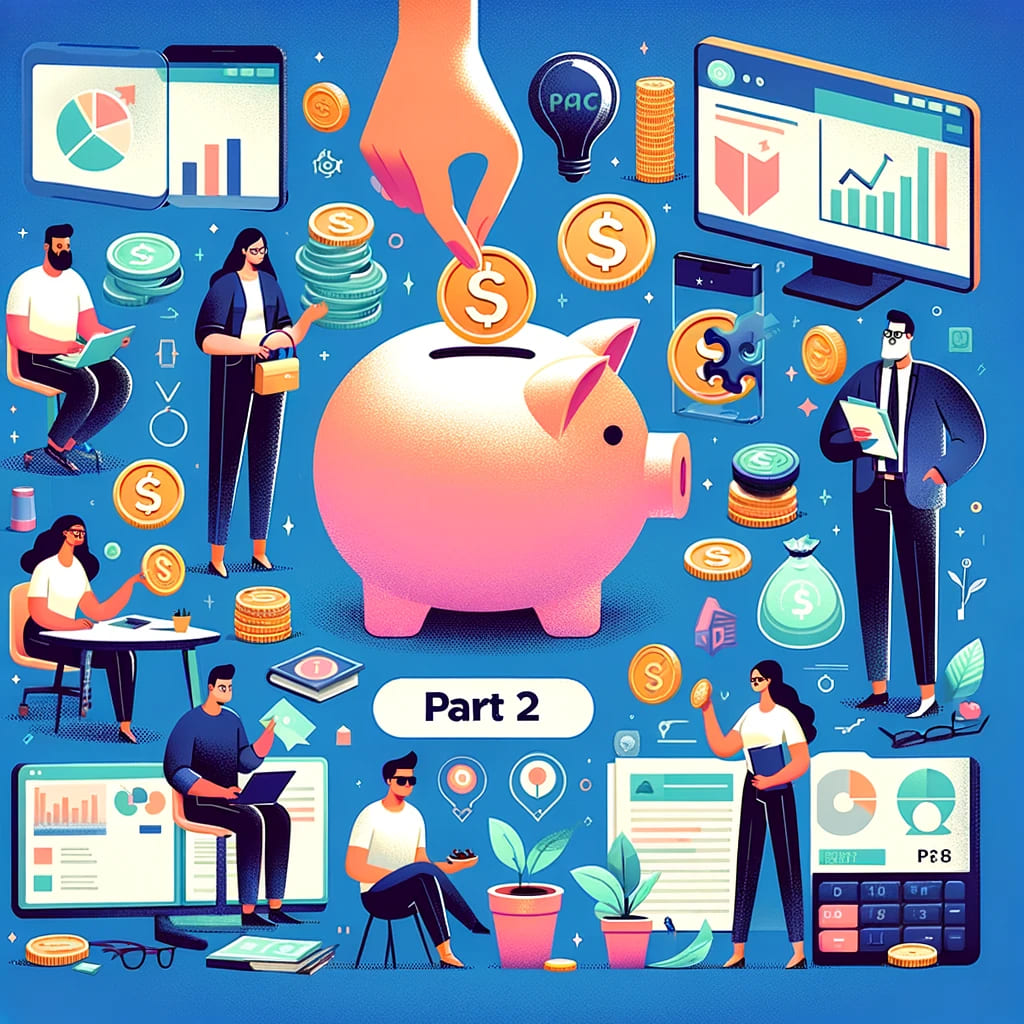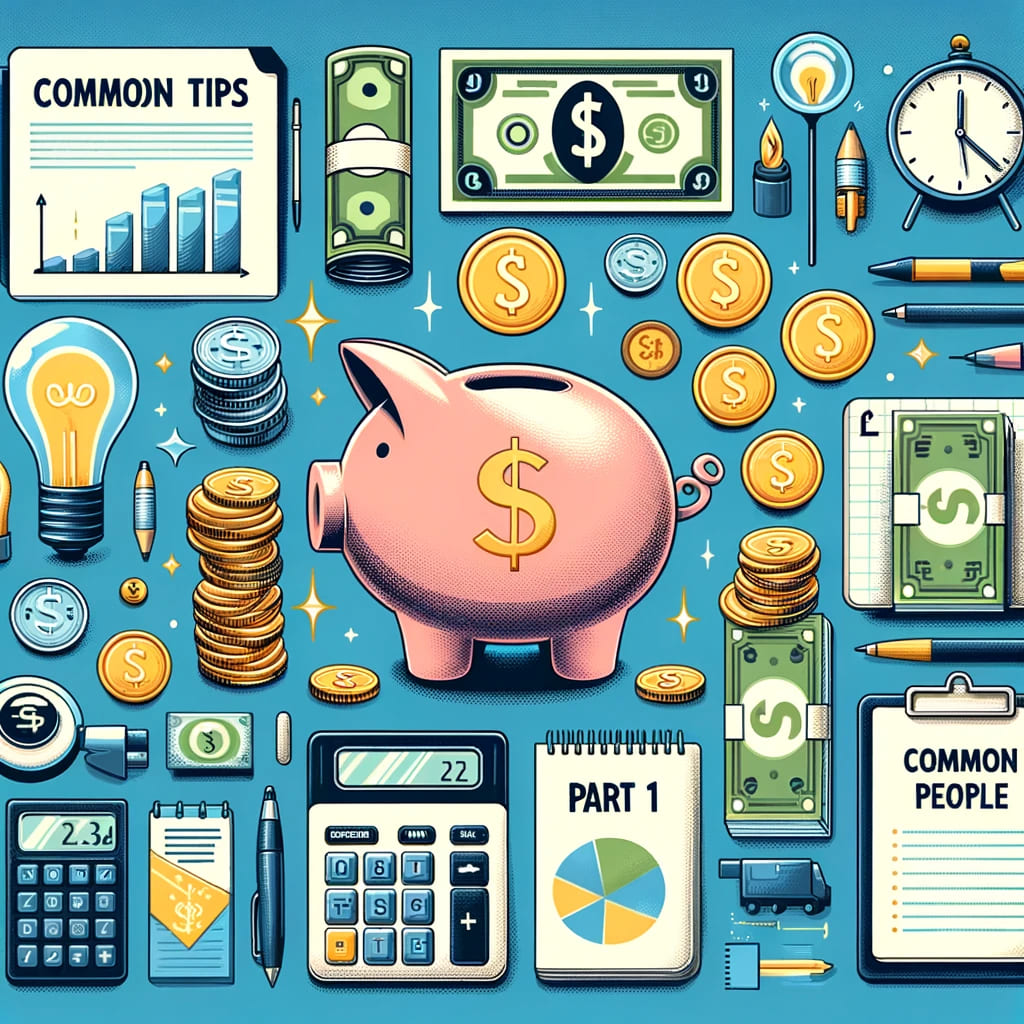Ten Financial Tips for the Common People (Part 2)
Practical Money Management in Daily Life
Mr. LianxiPosted on 2024-03-02 13:41:17
#financialmanagement
The previous article "Ten Financial Tips for the Common People: Practical Money Management in Daily Life (Part 1)" introduced the first five financial management methods. Have you mastered them? Let's continue with the next five great financial tips.
 Generated by OpenAI DALL·E 3
Generated by OpenAI DALL·E 3
6. Debt Management
Debt management refers to the effective control and adjustment of individual or family debts, aiming to optimize the debt structure, reduce debt costs, and ultimately reduce or pay off debt. Good debt management can not only help avoid excessive debt and financial crises but also improve an individual's credit score, creating more favorable conditions for future financial activities.
How to manage debt:
- Assess existing debts: Clearly list all debts, including loan amounts, interest rates, monthly payment amounts, and repayment terms.
- Determine debt repayment priorities: Decide on the repayment order based on the interest rate or other criteria (such as debt amount or psychological pressure). Debts with higher interest rates should generally be prioritized to reduce interest expenses.
- Develop a repayment plan: Based on income and expenditure, develop a practical debt repayment plan, which may include strategies such as increasing payment amounts, extending or shortening repayment periods.
- Consider debt restructuring or consultation: For high or unmanageable debts, consider debt restructuring or seeking professional consultation services, such as debt counseling or financial planning.
Example of debt management:
Marie has two debts: one is a credit card debt with an annual interest rate of 18%, amounting to 10,000 units; the other is a student loan with an annual interest rate of 5%, amounting to 50,000 units. Following the principle of prioritizing high-interest rates, she decides to focus on repaying the credit card debt first. By reducing unnecessary expenses and increasing income through part-time work, she makes an extra payment of 2,000 units per month, quickly reducing the credit card debt before shifting focus to the student loan.
Benefits of debt management:
- Reduce interest expenses: Effective management and prioritizing high-interest debt can significantly reduce overall interest expenses.
- Improve financial situation: Reducing debt burden can enhance an individual's financial health, increasing future financial flexibility and security.
- Improve credit score: Timely repayment and debt reduction can improve credit records and increase credit scores, beneficial for obtaining more favorable loan conditions in the future.
- Reduce psychological stress: Reducing debt and managing financial situations can significantly alleviate personal psychological stress and anxiety.
Debt management is a long-term and continuous process that requires individuals to have a clear understanding of their financial situation and strict self-discipline. When necessary, seeking professional financial consulting services is also a wise choice.
7. Energy-saving and Carbon Reduction Lifestyle
An energy-saving and carbon reduction lifestyle involves taking measures in daily life to reduce energy consumption and carbon emissions, promoting sustainable environmental development. This not only helps mitigate global climate change but also helps individuals and families reduce living costs, achieving financial savings.
How to live an energy-saving and carbon reduction lifestyle:
- Energy-efficient appliances: Choose home appliances with high energy efficiency, such as refrigerators, washing machines, and air conditioners with higher energy-saving labels, which consume less energy during use.
- Save water: Install water-saving devices, such as water-saving showerheads and toilets, and develop good water-saving habits.
- Smart temperature control: Use smart thermostats to control room temperature, avoiding excessive heating or cooling, and further saving energy.
- Green transportation: Prefer low-carbon modes of transportation, such as public transport, bicycles, or walking, to reduce the use of personal vehicles.
- Save electricity: Turn off unused electrical appliances and lights, utilize natural lighting, and use energy-saving products like LED bulbs.
Example of an energy-saving and carbon reduction lifestyle:
To reduce electricity and water bills, Margaret replaced all the light bulbs in her home with LED bulbs and installed a smart thermostat and water-saving showerhead. Additionally, she encourages her family to use public transport and bicycles as the main means of commuting to work and school. These measures not only reduce the family's monthly electricity and water bill expenses but also reduce the family's carbon footprint.
Benefits of an energy-saving and carbon reduction lifestyle:
- Reduce living costs: By reducing energy and water consumption, an energy-saving and carbon reduction lifestyle helps lower expenses such as electricity bills, water bills, and transportation costs.
- Improve quality of life: An energy-saving and carbon reduction lifestyle encourages healthy, environmentally friendly living habits, enhancing the overall quality of life for individuals and families.
- Protect the environment: Reducing energy consumption and carbon emissions helps mitigate climate change and protect the natural environment for future generations.
- Enhance environmental awareness: Practicing an energy-saving and carbon reduction lifestyle helps enhance individuals' and communities' awareness and sense of responsibility towards environmental protection.
Living an energy-saving and carbon reduction lifestyle is not only a way to save costs but also a responsible attitude towards the Earth. Through small changes in daily life, everyone can contribute to environmental protection while enjoying the economic and psychological benefits of energy savings.
8. Self-improvement and Investment in Education
Self-improvement and investment in education refer to investing in the enhancement of one's knowledge, skills, and abilities, which can not only increase an individual's market value and competitiveness but also serve as important pathways to personal growth and career goals. Through continuous learning and skill enhancement, individuals can explore more job opportunities, increase income potential, and strengthen their ability to adapt to rapidly changing environments.
How to achieve self-improvement and invest in education:
- Assess personal needs and goals: Determine the areas you wish to improve or learn, and how these improvements can help achieve career or personal development goals.
- Choose appropriate learning resources: Select suitable learning methods and resources based on personal needs, including online courses, night school, professional training, seminars, or books.
- Develop a learning plan: Create a practical learning plan, including a study schedule, goal setting, and progress tracking.
- Practice and apply: Apply the knowledge and skills learned to practical work, further consolidating and enhancing oneself through practice.
- Continuous learning: Recognize that learning is a continuous process; keep updating one's knowledge and skills as industries and technologies evolve.
Example of self-improvement and education investment:
Thomas, a marketing professional, wants to enhance his expertise in the digital marketing field. Through online research, he found several highly-rated online courses and set a plan to study 15 hours per week. After three months of study, he not only obtained a professional certificate in digital marketing but also successfully applied the newly learned skills to his work, helping the company improve its online sales performance. This not only increased his personal value but also brought him a promotion opportunity.
Benefits of self-improvement and education investment:
- Increase career competitiveness: Learning new skills and knowledge increases competitiveness in the workplace, leading to more job opportunities and promotions.
- Increase income potential: The enhancement of professional skills and knowledge often comes with opportunities for income growth.
- Adapt to industry changes: Continuous learning helps individuals adapt to industry development and technological changes, maintaining their relevance and professionalism.
- Personal growth: Learning new things not only enhances professional skills but also promotes overall personal development, improving problem-solving and innovation abilities.
Self-improvement and investment in education are crucial investments for an individual's future development. Regardless of the industry, continuous learning and growth are key to achieving career success and personal fulfillment.
9. Diversified Investment Portfolio
A diversified investment portfolio refers to the strategy of investing funds in different types of assets (such as stocks, bonds, real estate, precious metals, etc.) to spread risk. This strategy is based on a core principle: different types of assets perform differently under various market conditions. By investing in multiple assets, losses from poorly performing investments can be offset by gains from others, thus reducing the overall volatility and risk of the investment portfolio.
How to create a diversified investment portfolio:
- Assess risk tolerance and investment goals: Determine the appropriate asset allocation ratio based on an individual's risk tolerance, financial situation, and investment goals (such as capital appreciation, income growth, or retirement planning).
- Choose a variety of investment tools: Research and select different investment tools and asset classes, including but not limited to domestic and international stocks, government and corporate bonds, real estate investment trusts (REITs), commodities, and precious metals.
- Diversify investments: Further diversify investments within each selected asset class, for example, by choosing stocks from different industries and regions.
- Regularly evaluate and adjust the portfolio: Changes in market conditions and personal financial goals may necessitate adjustments to the investment portfolio. Regularly evaluate the portfolio and make adjustments as needed to maintain consistency with original investment objectives and risk tolerance.
Example of a diversified investment portfolio:
Amelia wants to increase her retirement funds. She chooses a diversified investment strategy, allocating her investments as follows: 40% in stocks (including domestic and international stocks from different industries), 30% in bonds (including government and high-rated corporate bonds), 20% in real estate investment trusts (REITs), and 10% in precious metals and commodities. Such distribution helps her maintain a stable performance of her investment portfolio under different market conditions.
Benefits of a diversified investment portfolio:
- Risk diversification: Diversified investments can reduce losses caused by the decline of a single asset or market.
- Stable returns: Diversified investment portfolios usually provide more stable returns across different economic cycles and market conditions.
- Increased flexibility: A diversified strategy offers more investment choices and opportunities, increasing flexibility to respond to market changes.
- Achieve long-term financial goals: By balancing risk and return, a diversified investment portfolio helps individuals achieve long-term financial goals, such as retirement planning and asset accumulation.
Building and maintaining a diversified investment portfolio requires time and effort, including continuous market research, investment selection evaluation, and regular portfolio adjustments. For investors lacking time or expertise, considering professional financial advisory services or investing in diversified fund products (such as mutual funds, ETFs) is also an effective way to achieve a diversification strategy.
10. Emergency Reserve Fund
An emergency reserve fund is a savings set aside specifically to deal with sudden financial situations, such as unemployment or medical emergencies. The main purpose of this fund is to provide a financial safety net, avoiding the need to borrow or use high-interest credit cards in emergencies, thus protecting individuals or families from sudden economic pressures.
How to prepare an emergency reserve fund:
- Determine the reserve amount: The generally recommended size of an emergency reserve fund is 3 to 6 months' worth of living expenses. The specific amount should be determined based on individual or family fixed expenses, job security, health conditions, and other factors.
- Set up a dedicated account: Establish a dedicated savings account for the emergency reserve fund, ensuring that the funds are easily accessible but not readily used for daily expenses.
- Regular deposits: Build and increase the emergency reserve fund gradually through automatic transfers or regular manual deposits.
- Regularly evaluate and adjust: Based on changes in living expenses and the use of the emergency reserve fund, regularly evaluate and adjust the size of the reserve.
Example of an emergency reserve fund:
Jane, a freelancer with fluctuating income, decides to establish an emergency fund sized at 6 months' worth of living expenses. Assuming her monthly living expenses are 20,000 units, she needs to prepare 120,000 units as an emergency fund. To achieve this goal, she sets up a dedicated account for the emergency fund in a high-interest savings account and sets up an automatic transfer of 2,000 units from her main account to the emergency fund account each month.
Benefits of an emergency reserve fund:
- Provide a financial safety net: In the event of unexpected incidents, an emergency reserve fund can offer necessary financial support, avoiding debt.
- Reduce financial stress: Having an emergency reserve fund can provide economic peace of mind, alleviating stress and anxiety caused by financial emergencies.
- Avoid high-interest loans and debt accumulation: Without an emergency reserve, people might have to rely on high-interest credit cards or loans to cope with emergencies, leading to debt problems.
- Enhance financial autonomy: An emergency reserve fund increases individuals' financial choices and autonomy in the face of unforeseen events.
Establishing and maintaining a sufficient emergency reserve fund is an important part of financial planning, providing crucial financial security for individuals or families and serving as the foundation for long-term financial stability and safety.
The Path to Financial Management Lies in Continuous Learning and Timely Adjustment
When practicing these financial strategies, it is important to continue learning and adapting, as personal financial situations and market conditions change over time. Moreover, these financial methods emphasize the need for a comprehensive financial strategy, from daily expense management to long-term investment planning, to help individuals and families maintain financial stability and grow financially in the face of uncertainties. Lastly, remember that the key to financial management is persistence and making appropriate adjustments according to individual circumstances.






















